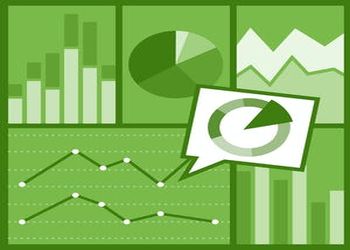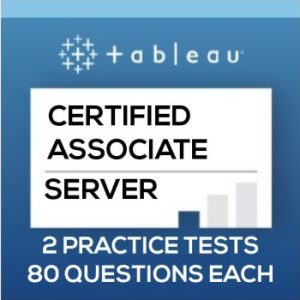Following is a must-have list of Tableau Interview Questions with detailed answers and core concepts. If you prepare the following Tableau Interview Questions well, you’ll feel more comfortable in a Tableau Interview. We’ll highly recommend improving your practical skills as well. Follow here for What is Tableau career guide. Also getting certified in tableau increases your skills and chances to land your dream job.
Top 10 Interview Questions on Tableau with Answers
- Can you please explain Tableau and its different products?
- What is the difference between Tableau Server and Tableau online?
- What are the different Tableau files?
- Can you identify the main difference between published data sources and embedded data sources in Tableau?
- Where does tableau store data extracts by default?
- What are the measures and dimensions in Tableau?
- What do you mean by aggregation in Tableau and what is default aggregation method in Tableau?
- Define data blending and joining in Tableau and give an example to elaborate both?
- What is context filter and why we use in Tableau reports?
- Tableau Forecasts are computed using exponential smoothing (True/ False)
More Tableau Scenario-based Interview Questions and Answers
- How do you implement security in Tableau?
- Your server admin has recently upgraded Tableau Server from an older version to a newer version. After upgrade of Tableau Server, what is the impact on existing Tableau desktop developers, do they need to upgrade their desktop versions in order to publish their workbooks?
- One of our extracts is taking a long time to refresh. What are the possible solutions that can be applied to make its refresh faster?
- In our organization, all workbooks are based on extracts and there is a policy that extracts are refreshed at 7 AM in the morning. One fine morning CEO calls and informs that’s its 0730 AM but still, data is not refreshed in the Tableau reports. Upon checking you realize that extract responsible for that particular report is still in the queue to be refreshed. What could be possible cause and solution?
- It is notified to you that one of the workbooks is taking a longer time to load and its performance is very poor. What different strategies you can opt to dig out the reason for taking time while loading and its poor performance?
- We have a requirement to create one site for our organization and project for each department like finance, sales, marketing etc. We want to apply a policy that finance users should not be able to download the data whereas, for all projects, users should be able to download the workbooks and download the data. What is the best possible option to apply this policy?
- We have developed a sales dashboard and provided access to users, users have raised a requirement to get the same dashboard over email with the latest update on a daily basis. Does Tableau provide any such feature to entertain it?
- We have recently went live with our sales dashboard. Our CEO has raised concern over the workbook name and he wants to modify the name from ‘Sales Dashboard’ to ‘Sales Executive Dashboard’. In order to modify it, do you need to republish the workbook?
- For a recently launched dashboard, the user is complaining that he is not able to user the filters. Have you faced such a scenario? What is the solution to it?
- Can you install multiple tableau desktop versions on the same development machine?
List of Tableau Interview Questions and Answers
Q1. Can you please explain Tableau and its different products?
A tableau is a tool that is helpful in visualization and it gives immense strength to business users to make the right decision based on data analysis.
Following are the main products of Tableau:
Tableau Desktop: It is a development tool which helps to visualize the data. It is so much powerful that you can get the insight of the data in a few minutes.
Tableau Prep: It is comprised of the following two products. Once is Tableau Prep Builder which is used for building your data flows. Whereas Tableau Prep Conductor is mainly for making schedules, monitoring flows along with managing flows across your organization.
Tableau Online: It is an analytics platform hosted in the cloud. It allows you to publish dashboards and share your discoveries with anyone online. Using this platform you can invite your colleagues or your customers to explore and interact with data and see visualization developed in Tableau.
Tableau Server: It is Tableau server which allows you to publish your dashboards through Tableau Desktop and share them throughout your organization.
If you’re interested in getting tableau certification, feel free to check out all tableau certification-related material including tableau certification dumps, free quizzes and complete certification practice exams on tableau desktop as well as the server. If you feel, you need to improve your skills, you can take FREE Online Tableau Training as well.
Q2. What is the difference between Tableau Server and Tableau online?
- Tableau server is like your webserver hosted in your enterprise network which will be accessible through your enterprise network users whereas Tableau online is hosted on a cloud server and is similar to tableau server hosted on a cloud platform.
Q3. What are the different Tableau files?
Tableau uses a different type of files in order to provide business answers. Following is a list of the available file type in the Tableau
- Tableau Workbook (.twb)
- Tableau Packaged Workbook (.twbx)
- Tableau Data Source (.tds)
- Tableau Packaged Data Source (.tdsx)
- Tableau Data Extract Files (.tde) –initially this extension was introduced
- Tableau Data Extract Files (.hyper) –Now Extracts are created in .hyper
- Tableau Bookmark (.tbm)
- Tableau Preferences (.tps)
- Tableau Map Source (.tms)
Q4. Can you identify the main difference between published data sources and embedded data sources in Tableau?
The published data source is available to other users which they can use in the development of other workbooks and dashboard.
The embedded data source is a data source used in a workbook and cannot be used by any other workbook.
Q5. Where does tableau store data extracts by default?
The default location of Tableau extracts is the location pointed to by the system’s %TEMP%
environment variable for all temporary files used in the process of creating extracts.
Tableau Server uses the folder :\ProgramData\Tableau\Tableau Server\data\tabsvc\temp.
Q6. What are the measures and dimensions in Tableau?
Tableau splits the data into two major types: dimensions and measures. Dimensions are usually those fields that cannot be aggregated; measures, as its name suggests, are those fields that can be measured, aggregated, or used for mathematical operations.
Example of dimension are
• City
• Grade
• Country
Example of Measure are
• Sales
• Profit
• No of Students in a class
Q7. What do you mean by aggregation in Tableau and what is default aggregation method in Tableau?
When you add a measure to the view, Tableau automatically aggregates its values. Sum, average and median are common aggregations.
Default aggregation method is SUM().
Tableau Certification Dumps & Practice Test:
We have full-length Tableau Specialist as well as Certified (previously called Qualified) Associate practice test and exams to give you enough practice material to prepare for the exam.
Check out our Tableau certification dumps, complete Tableau Certification Practice Test, Tableau certification mock Tests and Tableau certification free sample questions & Quizzes here:
Q8. Define data blending and joining in Tableau and give an example to elaborate both?
One of the main features is data blending in Tableau. When there are multiple data sources which you need to analyze together in a single view, you can go ahead with data blending option. For example, suppose the data of sales exist in a relational database whereas Sales Target figures are in an Excel file. You can blend both data sources to give a combined view.
When we have data between two or more tables or sheets which exists within the same Data Source, we can use the data joining technique to the single view. Example: Combining two tables from the same SQL Server database.
Q9. What is context filter and why we use in Tableau reports?
All filters that you set in Tableau are computed independently by default.
It is the default behaviour that filters placed in Tableau are computed independently That is, each filter accesses all rows in your data source without regard to other filters.
However, there is an option using which you can set one or more categorical filters as context filters in the view.
Context filter can be regarded as an independent filter. Any other filters that you set, process only the data that passes through the context filter which makes them dependent filters.
You may create a context filter for any of the following reason:
- In order to improve performance of the reports– When you set a lot of filters or have a large data source, it is observed that the queries can become slow so in such cases you can use the technique to set one or more context filters to improve the performance of your sheet.
- Create a dependent numerical or top N filter – You can set a context filter to include only the data of interest, and then set a numerical or a top N filter.
Q10. Tableau Forecasts are computed using exponential smoothing (True/ False)
It is true because Tableau Forecasts are computed using exponential smoothing.
A tableau is an amazing tool for Data Visualization. Preparing above given Tableau interview questions will be helpful in any level of Tableau Interview.
Scenario-Based Interview Questions on Tableau:
Q11. How do you implement security in Tableau?
There are two ways through which you can implement security in the Tableau.
Maintaining security in database
You can maintain user security through the database . Following are high-level steps to achieve security at database level
- Create a user table in a database containing the user and its privileges
- Create a Datasource in Tableau workbook
- Join your user table with your data table in the data source to validate the security based on your business requirement like based on department, organization or country etc.
- Create a user filter in the calculation field
- User this user filter in your sheets to filter the data
Maintaining security in Server Groups
- You can maintain the row-level user security using server groups. Following are high-level steps to achieve security at Tableau Server Groups
- Creating Groups in the Tableau Server
- Assign users to these groups according to users privileges
- Write a calculated field for user filter where you can user ISMEMBEROF function to validate users
- Use this user filter in your sheets to validate the data
Q12. Your server admin has recently upgraded Tableau Server from an older version to a newer version. After upgrade of Tableau Server, what is the impact on existing Tableau desktop developers, do they need to upgrade their desktop versions in order to publish their workbooks?
As a result of Tableau Server upgrade, existing Tableau desktop developers does not necessarily upgrade in order to publish the workbooks. When they will try to publish, they will receive a warning but workbook will be published successfully in the Tableau Server.
 Fundamentals of Visualization with Tableau
Fundamentals of Visualization with Tableau
- University of California via Coursera
- 11 hours of effort required
- 111,158+ already enrolled!
- ★★★★★ (4,671 Ratings)
 Data Visualization and Communication with Tableau
Data Visualization and Communication with Tableau
- Duke University via Coursera
- 25 hours of effort required
- 175,244+ already enrolled!
- ★★★★★ (2,852 Ratings)
 Tableau A-Z: Hands on Tableau Training for Data Science
Tableau A-Z: Hands on Tableau Training for Data Science
- Kirill Eremenko via Udemy
- 9 hours on demand videos
- 230,147+ already enrolled!
- ★★★★★ (60,907 ratings)
Q13. One of our extracts is taking a longer time to refresh. What are the possible solutions that can be applied to make its refresh faster?
It can be analyzed by going through the business requirement for that extract to do a complete refresh or incremental refresh.
Extracts can be configured to refresh on an incremental basis. This way extract refresh, will bring the delta of changes in the data and will refresh much faster and in a shorter time.
Q14. In our organization, all workbooks are based on extracts and there is a policy that extracts are refreshed at 7 AM in the morning. One fine morning CEO calls and informs that even at 0730 AM data is not refreshed in the Tableau reports. Upon checking you realize that extract responsible for that particular report is still in the queue to be refreshed. What could be possible cause and solution?
All extracts jobs are submitted depending on the priority defined while creating the extracts. The default priority is 50. In case you want to make sure that extract gets refreshed on priority, you can set this priority number to a lower number. Lower the priority number, earlier it will be picked to refresh. This priority number ranges from 0 to 100. 0 being the highest priority.
For the above-mentioned scenario, priority number can be modified so that the CEO should see the latest data after 7 AM.
Q15. It is notified to you that one of the workbooks is taking a longer time to load and its performance is very poor. What different strategies you can opt to dig out the reason for taking time while loading and its poor performance?
Performance recorder can be used to identify the areas which are a candidate to optimize. Performance recorder gives you a complete timeline for loading and executing events and all other calculations which takes time. This gives you immense control and awareness to know about the load time and time delaying areas.
As per Tableau provided guideline following points should be considered in Tableau Dashboards development.
- Minimize the use of Drop Down filters, instead try to use action filters
- In the default view, try to show the summary level reducing the number of records and show the detail upon click-through action filters
- Use extracts where possible instead of Live connections
Q16. We have a requirement to create one site for our organization and project for each department like finance, sales, marketing etc. We want to apply a policy that finance users should not be able to download the data whereas, for all projects, users should be able to download the workbooks and download the data. What is the best possible option to apply this policy?
Permission can be controlled on the Workbooks level or the Project level. Tableau provides an option where you can configure the permission at the project level and lock the permission to be set at the workbook level. In this way whatever setting you set at the project level, will supersede the permissions at workbook level. It is very useful when you want to apply project level permission policies.
For above-mentioned requirement, you can create One Site and it can have multiple projects. One project for each line of business like Finance, HR etc. and apply permission at project level according to business requirements.
Q17. We have developed a sales dashboard and provided access to users, users have raised a requirement to get the same dashboard over email with latest update on daily basis. Does Tableau provides any such feature to entertain it?
Tableau provides a subscription option where users can subscribe to have an email alert to get the dashboard. Tableau Server Admin can also subscribe any dashboard on behalf of any user (who does not have subscribe option enabled for his/ her user).
While sending the dashboard email alert, Tableau takes care of security and only relevant data is shared in email alerts.
Q18. We have recently went live with our sales dashboard. Our CEO has raised concern over the workbook name and he wants to modify the name from ‘Sales Dashboard’ to ‘Sales Executive Dashboard’. In order to modify it, do you need to republish the workbook?
Tableau Server provides an option to rename the published tableau workbooks. In order to rename the dashboard from ‘Sales Dashboard’ to ‘Sales Executive Dashboard’, you don’t need to re-publish, you can simply rename the workbook.
Q19. For a recently launched dashboard, the user is complaining that he is not able to use the filters. Have you faced such a scenario? What is the solution to it?
When we publish a workbook on Tableau server, there is a permission option that can be configured to control the access options for users.
If the filter option is disabled, filters are not available to users. In order to fix this, you can either publish the workbook again selecting the filter option for the users or permissions can be set through server administrator for a published workbook.
Q20. Can you install multiple tableau desktop versions on the same development machine?
Yes, multiple versions of Tableau Desktop can exist on the same development machine enabling the developer to work for various versions of Tableau at the same time.
Author Bio:
Syed Farhan Ashraf is an expert professional working for enterprise BI solutions and helping his clients in managing large scale projects. He has expertise in data integrations, developing dashboards using Tableau, Python and other data visualization and analysis tools. An active member of the Tableau community in providing training and guidance to newbies.






